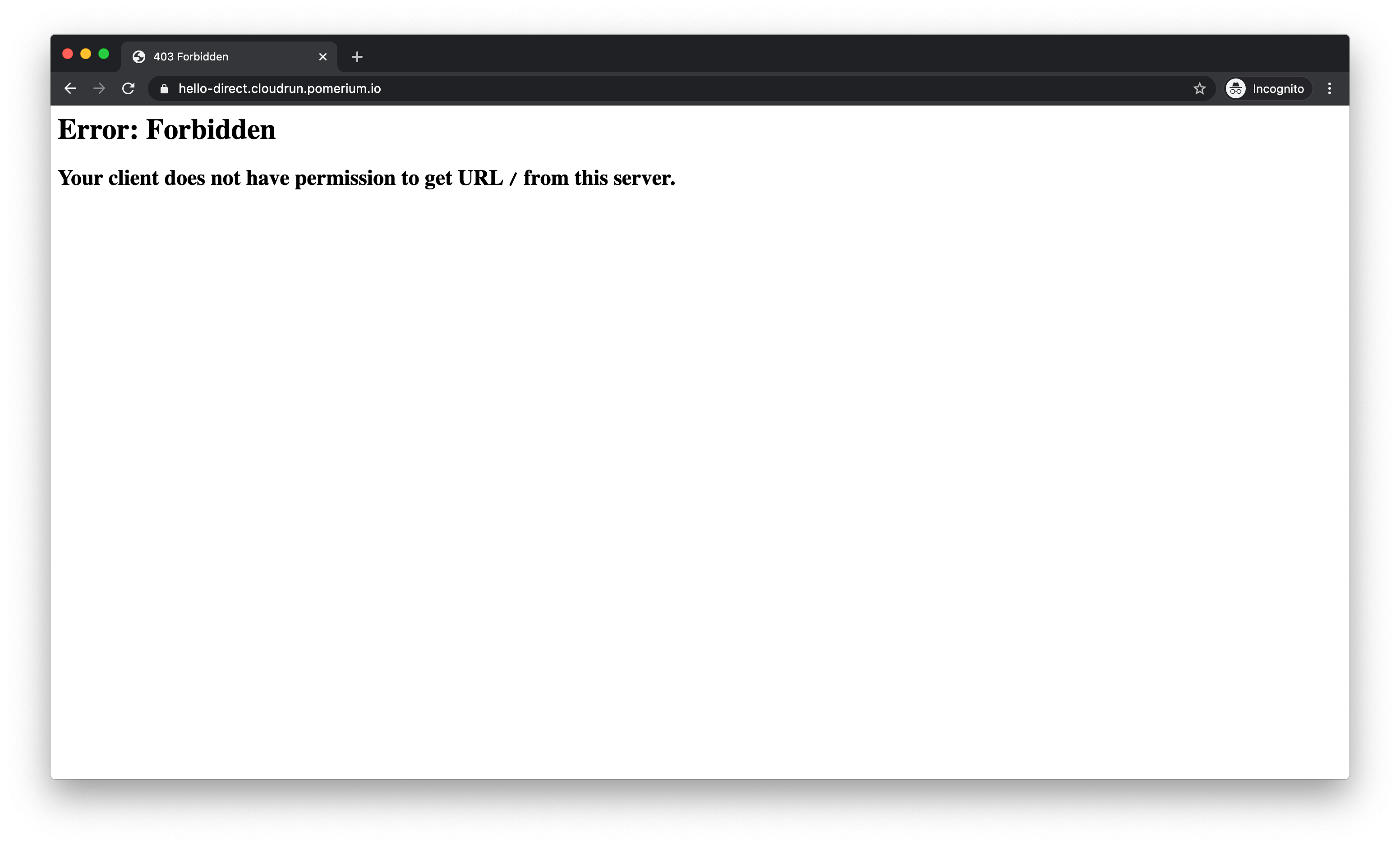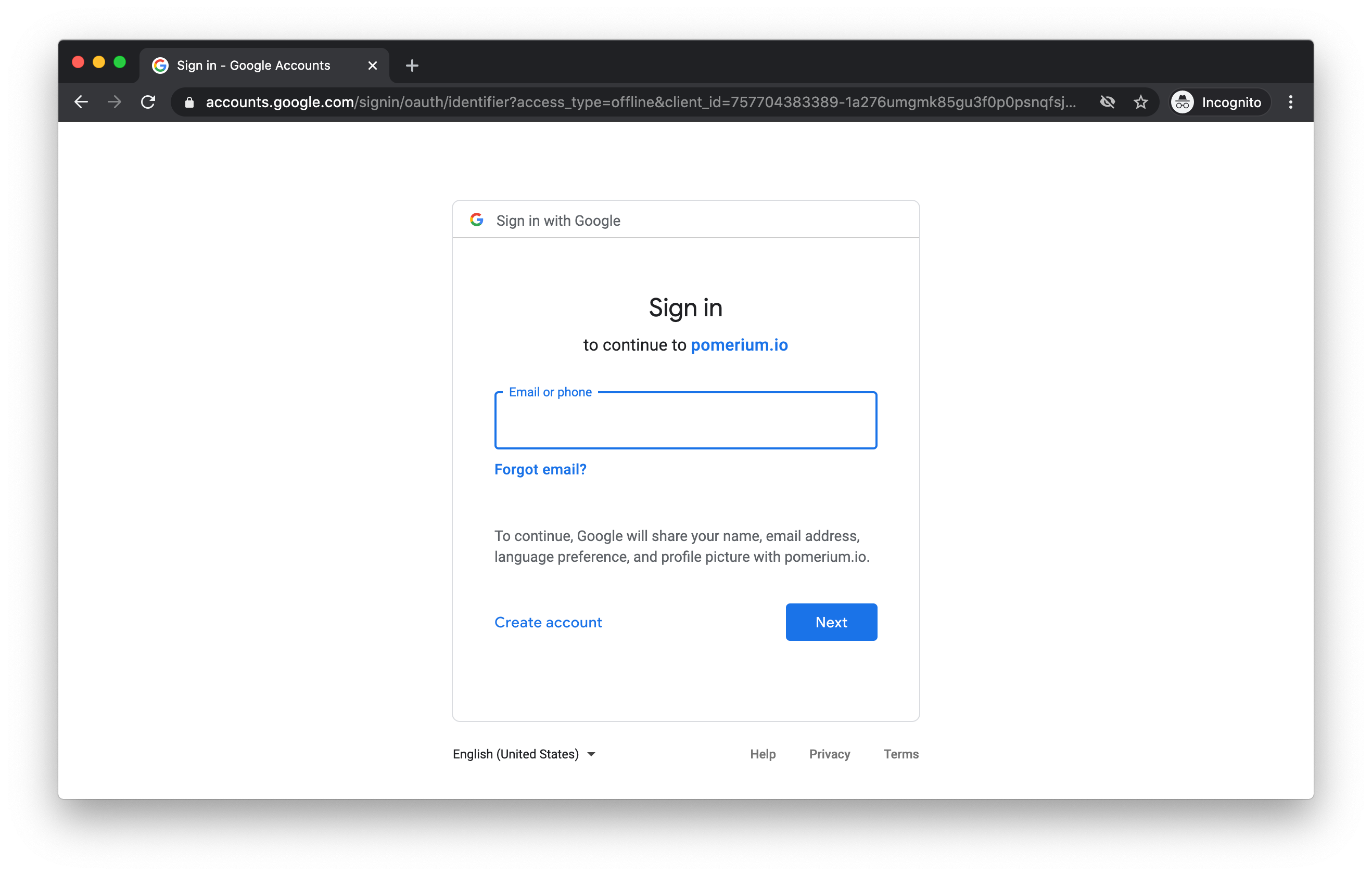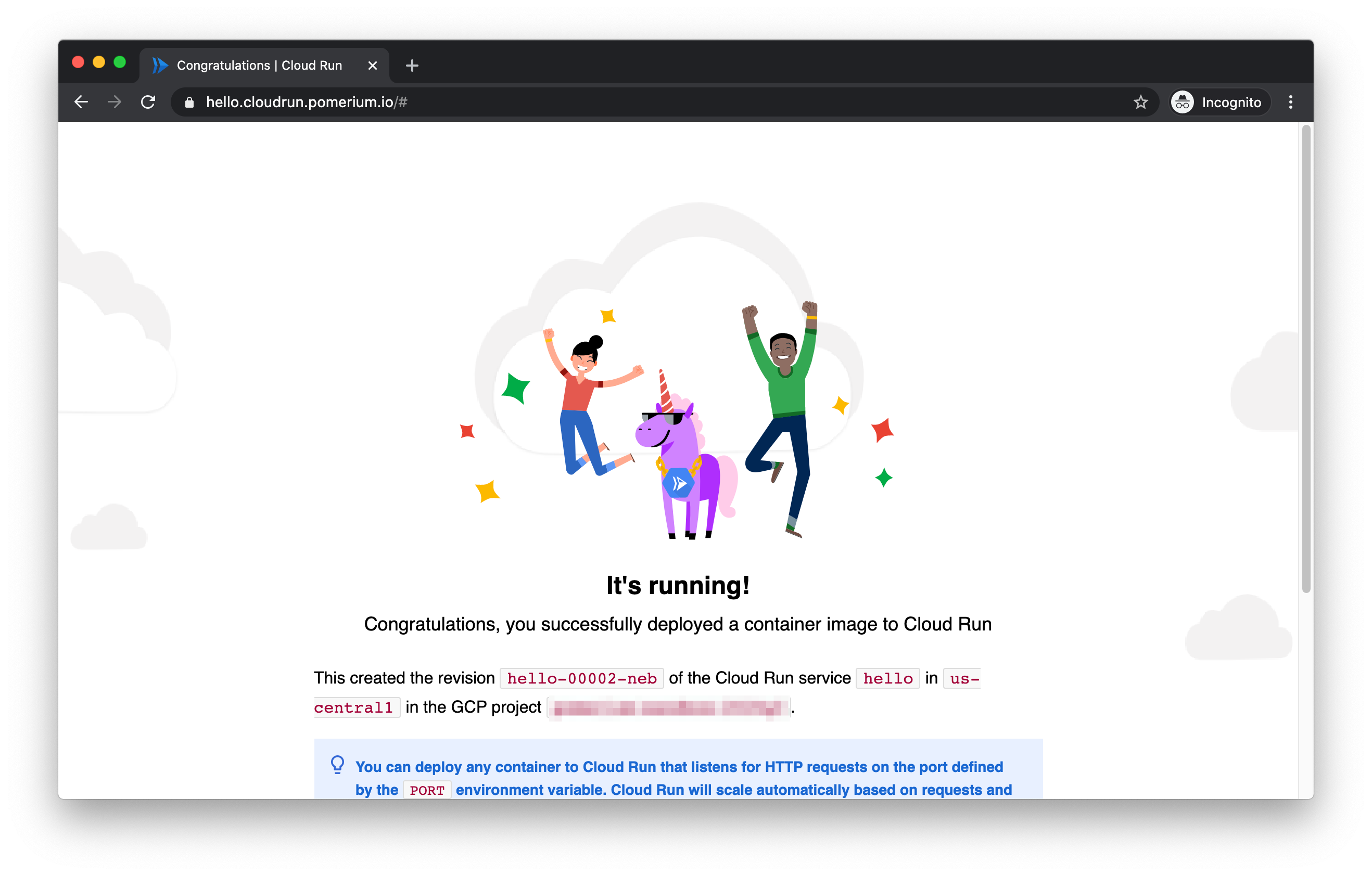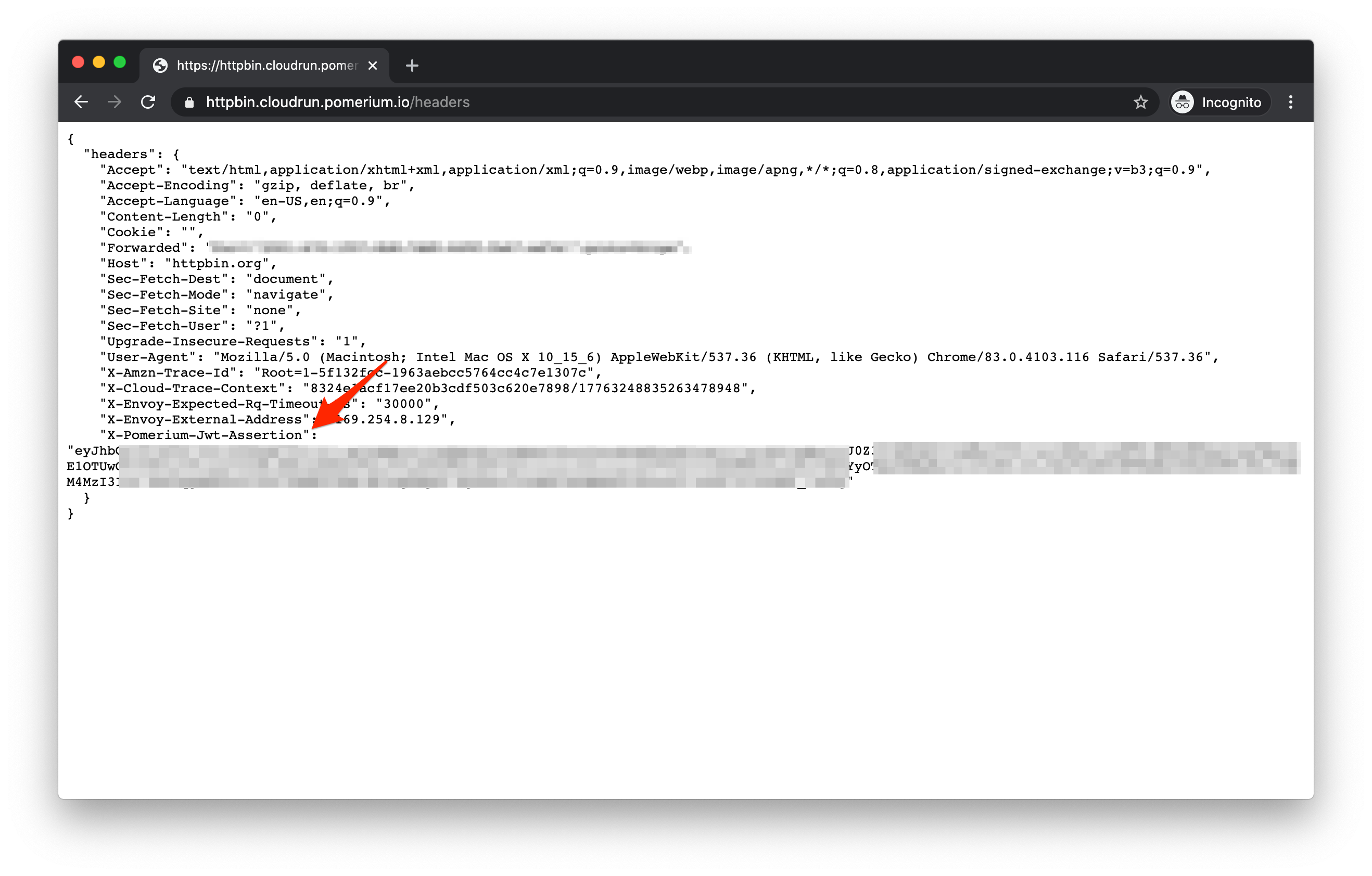Securing Cloud Run endpoints
This guide is outdated and will not work with Pomerium's current environment settings. We are actively working on updating the guide so that it's compatible with the latest versions of Google Cloud and Pomerium Core.
See this GitHub issue for more information, or refer to the v0.17.0 Cloud Run guide for a working version.
This recipe's sources can be found on github
Background
Services on Cloud Run and other Google Cloud serverless products can be restricted to only permit access with a properly signed bearer token. This allows requests from other services running in GCP or elsewhere to be securely authorized despite the endpoints being public.
These bearer tokens are not easily set in a browser session and must be refreshed on a regular basis, preventing them from being useful for end user authorization. Pomerium, however, can generate compatible tokens on behalf of end users and proxy the request to these services.
How it works
- Add an IAM policy delegating
roles/run.invokerpermissions to a service account - Run Pomerium with access to a key for the corresponding service account
- Publish DNS records for each protected application pointing to Pomerium
- Configure Pomerium with appropriate policy and
enable_google_cloud_serverless_authentication
The protected application delegates trust to a GCP service account which Pomerium runs as, and Pomerium performs user based authorization on a per route basis. This turns Pomerium into a bridge between a user-centric and service-centric authorization models.
Pre-requisites
This guide assumes you have Editor access to a Google Cloud project which can be used for isolated testing, and a DNS zone which you are also able to control. DNS does not need to be inside Google Cloud for the example to work.
Set Up
To deploy Pomerium to Cloud Run securely and easily, a special image is available at gcr.io/pomerium-io/pomerium:[version]-cloudrun. It allows sourcing configuration from GCP Secrets Manager, and sets some defaults for Cloud Run to keep configuration minimal. We will be leveraging it in this example to store IdP credentials. Our policy contains no secrets so we can place it directly in an ENV var.
Dockerfile Based on vals-entrypoint
The image expects a config file at /pomerium/config.yaml. Set VALS_FILES=[secretref]:/pomerium/config.yaml and set any other Pomerium Environment Variables directly or with secret refs such as ref+gcpsecrets://PROJECT/SECRET(#/key]).
Config
Set up a config.yaml file to contain your IdP credentials and secrets:
authenticate_service_url: https://authn.cloudrun.pomerium.io
shared_secret: XXXXXX
cookie_secret: XXXXXX
idp_provider: "google"
idp_client_id: XXXXXX
idp_client_secret: "XXXXXX"
Substitute cloudrun.pomerium.io for your own subdomain and your e-mail domain if appropriate:
- from: https://hello.cloudrun.pomerium.io
to: ${HELLO_URL}
allowed_domains:
- gmail.com
enable_google_cloud_serverless_authentication: true
- from: https://verify.cloudrun.pomerium.io
to: https://verify.pomerium.com
pass_identity_headers: true
allowed_domains:
- gmail.com
DNS
Substitute cloudrun.pomerium.io for your own subdomain (zonefile.txt):
*.cloudrun.pomerium.io. 18000 IN CNAME ghs.googlehosted.com.
Or set an equivalent CNAME in your DNS provider.
Deploy
Ensure you have set a default project:
gcloud config set default-project MY_TEST_PROJECT
#!/bin/bash
# Install gcloud beta
gcloud components install beta
# Capture current project number
PROJECT=$(gcloud projects describe $(gcloud config get-value project) --format='get(projectNumber)')
# Point a wildcard domain of *.cloudrun.pomerium.io to the cloudrun front end
gcloud dns record-sets import --zone pomerium-io zonefile --zone-file-format
# Deploy our protected application and associate a DNS name
gcloud run deploy hello --image=gcr.io/cloudrun/hello --region us-central1 --platform managed --no-allow-unauthenticated
gcloud run services add-iam-policy-binding hello --platform managed --region us-central1 \
--member=serviceAccount:${PROJECT}-compute@developer.gserviceaccount.com \
--role=roles/run.invoker
gcloud beta run domain-mappings --platform managed --region us-central1 create --service=hello --domain hello-direct.cloudrun.pomerium.io
# Rewrite policy file with unique 'hello' service URL
HELLO_URL=$(gcloud run services describe hello --platform managed --region us-central1 --format 'value(status.address.url)') envsubst <policy.template.yaml >policy.yaml
# Install our base configuration in a GCP secret
gcloud secrets create --data-file config.yaml pomerium-config --replication-policy automatic
# Grant the default compute account access to the secret
gcloud secrets add-iam-policy-binding pomerium-config \
--member=serviceAccount:${PROJECT}-compute@developer.gserviceaccount.com \
--role=roles/secretmanager.secretAccessor
# Deploy pomerium with policy and configuration references
gcloud run deploy pomerium --region us-central1 --platform managed --allow-unauthenticated --max-instances 1 \
--image=gcr.io/pomerium-io/pomerium:latest-cloudrun \
--set-env-vars VALS_FILES="/pomerium/config.yaml:ref+gcpsecrets://${PROJECT}/pomerium-config",POLICY=$(base64 policy.yaml)
# Set domain mappings for the protected routes and authenticate
gcloud beta run domain-mappings --platform managed --region us-central1 create --service=pomerium --domain hello.cloudrun.pomerium.io
gcloud beta run domain-mappings --platform managed --region us-central1 create --service=pomerium --domain authn.cloudrun.pomerium.io
gcloud beta run domain-mappings --platform managed --region us-central1 create --service=pomerium --domain httpbin.cloudrun.pomerium.io
Results
Overview
We should see two applications deployed. The hello app is our protected app, and pomerium is...Pomerium!

Notice that Pomerium allows unauthenticated access, but hello does not.
Here are the domain mappings set up:

Direct Access
Let's verify we cannot access the main application directly by visiting https://hello-direct.cloudrun.pomerium.io

You should see a 403 error because you do not have the proper credentials.
Authenticated Access
Now let's access via https://hello.cloudrun.pomerium.io
We should get an auth flow through your IdP:

And a hello page:

Non-GCP Applications
If your target application is not running on GCP, you can also perform your own header validation.
Browse to https://verify.cloudrun.pomerium.io
You should see your identity header set:

See getting user's identity for more details on using this header.
